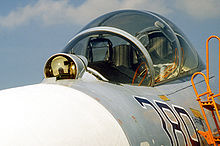Sukhoi Su-27
| Su-27 | |
|---|---|
| Su-27UB of the Russian Knights aerobatic team | |
| Role | Air superiority fighter |
| National origin | Soviet Union / Russia |
| Manufacturer | Sukhoi |
| First flight | 20 May 1977 |
| Introduction | December 1984 |
| Status | In service |
| Primary users | Russian Air Force Chinese Air Force Ukrainian Air Force See operators for others |
| Produced | 1984–current |
| Number built | 680 |
| Unit cost | US$30 million |
| Variants | Sukhoi Su-30 Sukhoi Su-33 Sukhoi Su-34 Sukhoi Su-35 Sukhoi Su-37 Shenyang J-11 |
There are several related developments of the Su-27 design. The Su-30 is a two-seat, dual-role fighter for all-weather, air-to-air and air-to-surface deep interdiction missions. The Su-33 ‘Flanker-D’ is a navy fleet defence interceptor for use on aircraft carriers. Further versions include the side-by-side 2-seat Su-34 ‘Fullback’ strike variant and the Su-35 ‘Flanker-E’ improved air defence fighter.
Development
Background
In 1969, the Soviet Union learned of the U.S. Air Force's "F-X" program, which resulted in the F-15 Eagle. The Soviet leadership soon realised that the new American fighter would represent a serious technological advantage over existing Soviet fighters. What was needed was a better-balanced fighter with both good agility and sophisticated systems. In response, the Soviet General Staff issued a requirement for a Perspektivnyy Frontovoy Istrebitel (PFI, literally "Perspective Frontline Fighter", roughly "Advanced Frontline Fighter").[1] Specifications were extremely ambitious, calling for long range, good short-field performance (including the ability to use austere runways), excellent agility, Mach 2+ speed, and heavy armament. The aerodynamic design for the new aircraft was largely carried out by TsAGI in collaboration with the Sukhoi design bureau.[1]When the specification proved too challenging and costly for a single aircraft in the number needed, the PFI specification was split into two: the LPFI (Lyogkyi PFI, Lightweight PFI) and the TPFI (Tyazholyi PFI, Heavy PFI). The LPFI program resulted in the Mikoyan MiG-29, a relatively short-range tactical fighter, while the TPFI program was assigned to Sukhoi OKB, which eventually produced the Su-27 and its various derivatives. The TPFI program is similar to the American F-X program, which resulted in the F-15 Eagle, while the LPFI program is similar to the Lightweight Fighter program, which spawned the F-16 Fighting Falcon and the Northrop YF-17, which itself led to the F/A-18 Hornet.
Design phase
The Sukhoi design, which was altered progressively to reflect Soviet awareness of the F-15's specifications, emerged as the T-10 (Sukhoi's 10th delta wing design), which first flew on 20 May 1977. The aircraft had a large delta wing, clipped, with two separate podded engines and a twin tail. The ‘tunnel’ between the two engines, as on the F-14 Tomcat, acts both as an additional lifting surface and hides armament from radar. While being developed, it was spotted by a spy satellite at the Zhukovsky flight test center near the town of Ramenskoe, resulting in the temporary codename of 'Ram-K'. It was believed that the Ram-K was being developed in two versions: a swing-wing fighter similar in function to the Grumman F-14 and a two-seat fixed wing interceptor aircraft which in fact turned out to be the unrelated Mikoyan MiG-31.
Su-27 (T-10) in front of a Mil Mi-12.
The production Su-27 (sometimes Su-27S, NATO designation 'Flanker-B') began to enter VVS operational service around 1984, although manufacturing difficulties kept it from appearing in strength until 1986. The Su-27 served with both the V-PVO and Frontal Aviation. In V-PVO service it was primarily an interceptor aircraft, supplanting older aircraft like the Sukhoi Su-15.[citation needed] Although the Su-27 has some capacity to carry air-to-ground weapons, in Frontal Aviation it was primarily tasked with fighting its way past enemy lines to destroy tanker and AWACS aircraft.[citation needed] The Su-27 retains that role in CIS service, with later marks capable of carrying long-range "AWACS killer" missiles such as the Vympel R-37 and, potentially, the Novator K-100 when it enters production.
From 1986 a special Su-27 designated P-42, rebuilt from the prototype T-10S-3 aircraft and stripped to minimum weight, began to set the first in a series of performance records for rate of climb and altitude, the aircraft setting 27 new class records between 1986 and 1988.
Design

Sketch of Su-27 performing Pugachev's Cobra manoeuvre.
The Su-27’s Lyulka AL-31F turbofan engines are widely spaced, both for safety reasons and to ensure uninterrupted airflow through the intakes. The space between the engines also provides additional lift, reducing wing loading. Movable guide vanes in the intakes allow Mach 2+ speeds, and help to maintain engine airflow at high alpha. A mesh screen over each intake prevents debris from being drawn into the engines during take-off.
The Su-27 had the Soviet Union’s first operational fly-by-wire control system, developed based on Sukhoi OKB’s experience in the Sukhoi T-4 bomber project. Combined with relatively low wing loading and powerful basic flight controls, it makes for an exceptionally agile aircraft, controllable even at very low speeds and high angles of attack. In airshows the aircraft has demonstrated its manoeuvrability with a Cobra (Pugachev’s Cobra) or dynamic deceleration – briefly sustained level flight at a 120° angle of attack. Thrust vectoring has also been tested (and is incorporated on later Su-30MK and Su-37 models), allowing the fighter to perform hard turns with almost no radius, incorporate vertical somersaults into level motion and limited nose-up hovering.
The naval version of the ‘Flanker,’ the Su-27K (or Su-33), incorporates canards for additional lift, reducing take-off distances (important because the aircraft carrier Admiral Kuznetsov has no catapults). These canards have also been incorporated in some Su-30s, the Su-35, and the Su-37.
In addition to its considerable agility, the Su-27 uses its substantial internal volume for a large internal fuel capacity. In an overload configuration for maximum range, it can carry 9,400 kg (20,700 lb) of internal fuel, although its manoeuvrability with that load is limited, and normal load is 5,270 kg (11,620 lb).
The Su-27 is armed with a single 30 mm Gryazev-Shipunov GSh-30-1 cannon in the starboard wingroot, and has up to 10 hardpoints for missiles and other weapons. Its standard missile armament for air-to-air combat is a mixture of Vympel R-73 (AA-11 Archer), Vympel R-27 (AA-10 'Alamo') weapons, the latter including extended range and IR guided models. More advanced Flanker variants (such as Su-30, −35, −37) may also carry Vympel R-77 (AA-12 Adder) missiles.
The Su-27 has a high-contrast tuneable HUD and a Helmet mounted display capability.
Radar and sensors
The Su-27 is equipped with a Phazotron N001 Zhuk coherent pulse-Doppler radar with track-while-scan and look-down / shoot-down capability. The fighter also has an OLS-27 infrared search and track (IRST) system in the nose just forward of the cockpit with a 80–100 km range,[2] which also incorporates a laser rangefinder. This system can be slaved to the radar, or used independently for "stealthy" attacks with infrared missiles (such as the R-73 and R-27T/ET). It also controls the cannon, providing greater accuracy than a radar sighting mode.The radar proved to be a major developmental problem for the Su-27. The original Soviet requirement was very ambitious, demanding a multi-target engagement capability and 200 km range against "bombers" (16 m² RCS to match a Tu-16). This would be broadly comparable to the 1-ton Zaslon phased array radar used on the MiG-31.[citation needed]
To achieve this at a reasonable weight, the design team came up with a radar using electronic scanning for elevation and mechanical scanning for azimuth. Unfortunately, it proved too much for the Soviet microelectronics industry in the 1970s to achieve, and by 1982, the original Myesch program had to be abandoned and a less capable alternative array was selected. To make up the lost time, many matured technologies from the N019 Topaz radar, including an enlarged version of the twist-cassegraine array, on the MiG-29 was used, and as a result, the resulting N001 radar shared the same TS100 signal processor used on N019 Topaz radar, while N001V, the successor of N001, shared the same TS101M signal processor with N019M, the successor of N019. The radar only achieved a 140 km detection range versus the Tu-16, and could only engage a single target. Even then, the radar was initially beset by reliability problems and this caused the N001 to be accepted for service in 1991, half a decade after the Su-27 first entered service in 1986.[citation needed]
The first of the N001 series radar, the Tikhomirov (NIIR) N001 (NATO ‘Slot Back’), is a pulse-Doppler set with track-while-scan capability, but its processor is relatively primitive, making it vulnerable to false alarms and blind spots, as well as being more difficult to use. Over the years, under the chief designer of N001 radar, Professor Viktor Konstantinovitch Grishin, the N001 radar has been upgraded many times, resulting in derivatives including N001V, N001VE, N001VEP, all of which are in service, including those exported Flankers. Professor V.K. Grishin was the chief designer of Zaslon S-800 passive phased array radar on MiG-31, and the expertise would later contribute to the design of the replacement phased array radars for the N001 series.[citation needed]
It was apparent that there was limited room for improvement in the N001 series radar, and the Su-30 and Su-35/37 aircraft have the vastly superior Tikhomirov (NIIR) 'Bars' (Panther) N011M with a passive electronically scanned array, improving range, multiple target capability, and sensitivity. The Bars (Panther) radar is scheduled to be replaced by an even more capable successor, Irbis (Snow leopard)-E phased array radar in the near future. Tikhomirov (NIIR)’s competitor, Phazotron (NIIP) also offered a similar radar with a passive electronically scanned array.[citation needed]
While the Su-27 and its immediate descendants (Su-35 and −37) have outstanding manoeuvrability and performance, the airframe design lacks stealth features, so the radar cross section (RCS) is large. To reduce the RCS, a process called "plasma stealth" has been proposed which would create a charged plasma cloud which would be hard for radar to penetrate. This process is theoretically possible but very difficult to do so in practice. A Russian plasma stealth device had been tested on a Su-27IB by June 2002;[3] But this has been widely disputed















0 Comment:
Posting Komentar